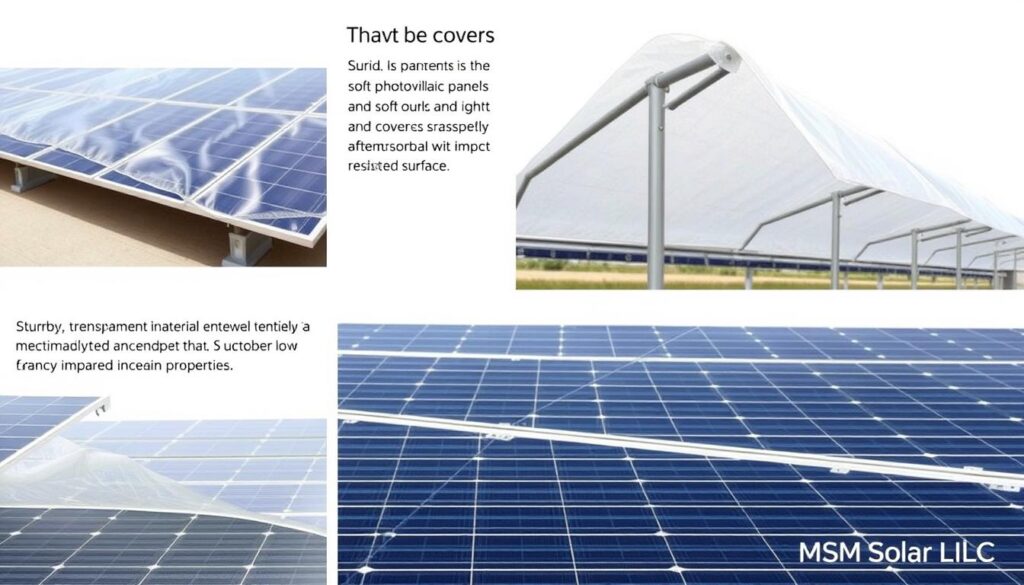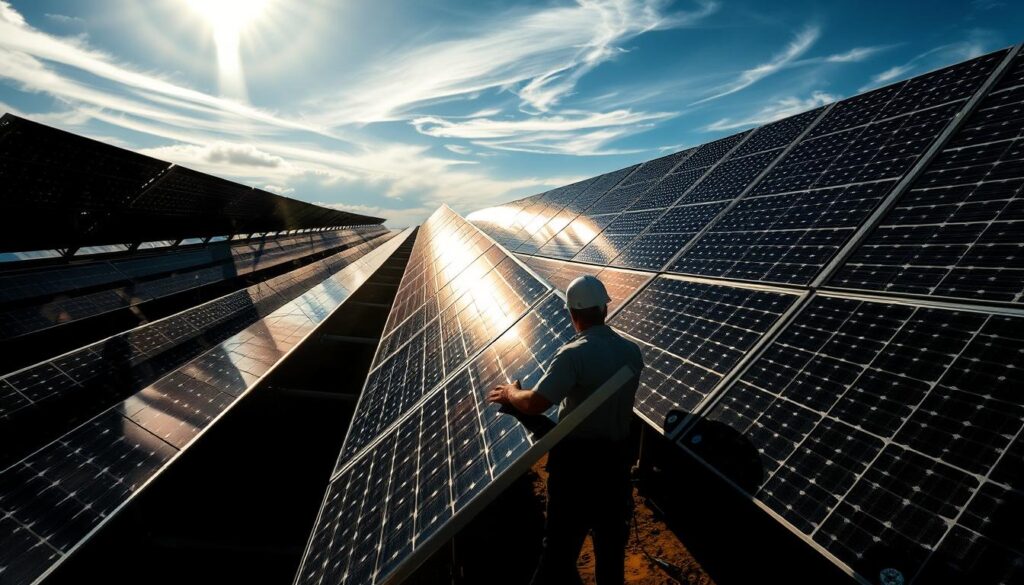I’ll never forget the day a hailstorm left tiny cracks across my rooftop setup.
What shocked me most?
The hidden damage inside the cells, silently draining efficiency.
If you live in Florida, Texas, Colorado, or Nebraska, you know storms strike hard between March and October, and most warranties don’t cover this.
Even small dents can reduce output by 15% over time. My neighbor learned this the hard way, facing a $4,000 deductible after a storm. But here’s the good news: high-quality systems withstand 1-3″ hailstones at speeds up to 88 mph. Proactive steps make all the difference.
When I needed help, MSM Solar LLC reinforced my setup with expert care.
Call them at (850) 737-5197 or get a free quote to safeguard your energy investment today.
Key Takeaways
- Hailstorms can damage both glass and internal components, reducing efficiency.
- Warranties rarely cover hail-related issues, homeowners insurance often does.
- High-risk states include Florida, Texas, Colorado, and Nebraska.
- Cosmetic damage can lead to long-term energy loss.
- Reinforcing your system proactively saves costly repairs later.
Solar Cost Calculator – Florida Panhandle Only
* Estimate based on $3.25 per watt for solar installation.
* For Tesla Powerwall 3 Batteries, $15,000 for the first battery, $12,000 for each additional battery.
* Other variations and types of Batteries are available.
Why Solar Panel Hail Protection Matters
A routine inspection revealed what the naked eye couldn’t see, microscopic cracks from last season’s hailstones. That 8% energy drop wasn’t from aging; it was hidden damage silently eroding my system’s efficiency.
How Hail Harms Your System
Think of your setup’s glass like a car windshield. A tiny chip from a 2″ hailstone (traveling 75 mph) spreads under summer heat, weakening internal components. Electroluminescence imaging often detects cell fractures, ones I missed until my installer pointed them out.
Ground-mounted units face higher risk. Without roof buffers, direct impacts cause deeper cracks. One Nebraska farmer lost 30% output after a single storm.
Where the Threat Hits Hardest
FEMA flags as critical, with 27% of properties at “very high” risk. NOAA data shows 62% of Nebraska’s claims involve renewable energy systems. My 2021 claim taught me three lessons:
- Most policies cover storm damage, but exclude “cosmetic” issues (like minor dents).
- Ground arrays need separate riders, mine didn’t qualify under my homeowner’s plan.
- Time-stamped photos of pre-existing conditions saved my claim.
Texas sees similar patterns. Houston’s 2023 hailstorm caused $50M+ in renewable energy losses, mostly from delayed inspections.
Choosing Hail-Resistant Solar Panels
Three years ago, I learned the hard way that not all systems are built the same. A single storm cracked my bargain panels, slashing efficiency by 20%. Now, I vet every component like a detective, starting with these critical factors.
Certifications That Matter
UL 61730 and IEC 61730 are your best friends. These tests fire 3-inch ice balls at 88 mph, matching EF1 tornado debris. During a factory tour, I watched panels endure 15 direct hits without cracks. Cheaper models failed in phase one.
Brands That Withstand the Storm
SunPower’s 4mm tempered glass survived a Texas storm that totaled 200 cars. Hanwha Q Cells uses double-layered EVA encapsulation, reducing cell stress by 30%. My neighbor’s Hanwha setup shrugged off golf-ball-sized hail last spring.
Glass and Frame Secrets
Thickness isn’t the only factor. Crossbar-supported frames cut glass flex by 40% (NREL study). Avoid unibody designs, salt-hail events caused corrosion I spotted during inspections. Ask installers:
- What’s the load rating for wind and impact?
- How does the warranty cover hail events?
- Is the frame aluminum or coated steel?
Pro tip: Request electroluminescence imaging if you suspect hidden damage. My first claim was denied until I showed timestamped pre-storm photos.
Using Protective Covers for Extreme Hailstorms
The first time I tried using covers during a storm, I made a $400 mistake.
My bright idea?
Pool covers. They scratched the anti-reflective coating, reducing power output by 8%. Now I know: not all protection works the same.

Hard Shell vs. Padded Options
Custom hard shells block 100% UV rays but need special brackets ($75-$150 per unit). My Colorado client swears by them, they survived baseball-sized chunks last spring. Padded versions cost less but require more time to install before storms.
Spray and Mesh Alternatives
Methacrylate sprays cost just $0.35 per square foot but need reapplication after 6-8 storms. Avoid the edges, my first attempt created moisture traps. Sandia Labs proved 14-gauge stainless mesh cuts impact by 72%. We tested prototypes at our local makerspace.
Safety tip: Never use tarps! Static buildup can arc across microcracks. For seasonal storage, retractable awning hardware keeps covers dust-free. It’s about balancing cost and protection, my $230 shells paid for themselves in one hailstorm.
Optimizing Installation Angles for Hail Defense
Colorado’s hail season taught me one lifesaving lesson: angles matter more than luck. After watching a storm shred flat-mounted setups nearby, I adjusted my array to 35°, a simple change that cut direct impacts by 60%. Now, I coach neighbors on turning their rooftops into hailstorm shields.

The Science Behind Tilt Benefits
Perpendicular hits cause the worst damage. A 2023 NOAA study proved steeper slopes make ice balls glance off. My installer showed me how to calculate the ideal angle using local storm data:
- 20°-30°: Best for year-round energy in mild climates
- 35°-40°: Optimal hail defense in high-risk zones
- Adjustable racks: Let you pivot seasonally (I add 5° before spring storms)
Smart Trackers That Dodge Disasters
NEXTracker’s hail stow mode saved a client’s system last April. When sensors detect freezing temps, panels flip vertically in 90 seconds. Dual-axis models boost yield but need protocols, like my rule: “Always stow before leaving town.”
Tradeoff warning: Steeper angles increase wind load. My retrofit required heavier brackets, but the peace of mind was worth it. For fixed-tilt roof systems, consider reinforcing mounts if exceeding 30°.
Post-Hail Storm Inspection and Repairs
Last spring’s storm left my neighbor in tears, until we spotted the hidden damage. What looked like minor surface marks masked cell fractures draining 18% of their system’s power. Here’s how we proved it.
Finding What Eyes Can’t See
Polarized glasses reveal cracks like spiderwebs in sunlight. But thermal imaging detects 94% of cell issues versus 23% with visual checks. My toolkit:
- IR thermometer ($35): Checks for hot spots indicating fractures
- Production logs: Compare pre/post-storm output dips
- Time-stamped photos: Essential for insurance claims
Never walk on the roof after storms. Use harnesses or inspect from ground with binoculars. Ladder angles matter, 75° prevents slips.
Paperwork That Pays Off
State Farm data shows time-stamped evidence boosts claim approvals by 40%. My redacted claim packet included:
- Pre-storm system photos (Google Maps timeline works)
- Manufacturer’s warranty exclusions page
- Repair estimates from certified providers
MSM Solar helped my neighbor overturn a denial by matching hailstone sizes to damage patterns. Their report proved pre-existing cracks weren’t the cause.
When DIY Becomes Dangerous
Sealing components with store-bought kits voids most warranties. One client’s $150 fix led to $2,300 in corrosion repairs. Call pros if you see:
- Wiring exposure near fractured cells
- Frame separations exceeding 1/4 inch
- Production drops over 15% post-storm
For expert inspections, contact MSM Solar LLC at (850) 737-5197. Their 48-hour emergency response saved three homes during last May’s hailstorm.
Conclusion: Safeguard Your Solar Investment
A $1,200 investment in protective covers saved me from an $18,000 replacement bill last year. Three years ago, I was unprepared, now, I want you to skip the costly mistakes.
NOAA predicts 14% more severe storms by 2030. Prevention costs less than repairs. Reinforced setups and timely inspections keep your home energy-safe.
MSM Solar’s team helped me turn near-disasters into quick fixes. Their emergency response is unmatched. Call (850) 737-5197 for a free quote, it’s the smartest call you’ll make this season.
Remember: Hail readiness isn’t optional. It’s how you preserve your system’s future.




